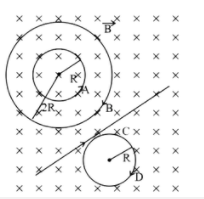A
B
C
D
Text Solution
Verified by Experts
The correct Answer is:
|
Topper's Solved these Questions
NTA NEET SET 27
NTA MOCK TESTS|Exercise PHYSICS|45 VideosView PlaylistNTA NEET SET 29
NTA MOCK TESTS|Exercise PHYSICS|45 VideosView Playlist
Similar Questions
Explore conceptually related problems
Knowledge Check
A
B
C
D
Submit
A
B
C
D
Submit
A
B
C
D
Submit
Similar Questions
Explore conceptually related problems
NTA MOCK TESTS-NTA NEET SET 28-PHYSICS
- During an adiabatic process, the pressure of a gas is found to be prop...
01:22
|
Play - A long wire bent as shown in the figure carries current I=10A. If the ...
12:53
|
Play - Four particles A, B, and C and D of masses m(A), m(B), m(B) and m(D) r...
02:23
|
Playing Now - A particle starts from rest and traverses a distance l with uniform ac...
05:02
|
Play - A car A is moving with speed "40 km h"^(-1) along a straight line 30^(...
04:01
|
Play - A symmetrical uniform solid cube of side 5 m is placed on horizontal s...
05:48
|
Play - Two deuterons undergo nuclear fusion to form a Helium nucleus. Energy ...
01:31
|
Play - The half - life of^(215) At is 100 mu , s.The time taken for the radio...
02:57
|
Play - An object of mass 1 kg executes simple harmonic oscillations along the...
02:09
|
Play - A child swinging on a swing in sitting position, stands up, then the t...
01:15
|
Play - In the photoelectric effect, the maximum speed of electrons is found t...
03:03
|
Play - A beam of white light is incident normally on a plane surface absorbin...
03:13
|
Play - A stream of water of density rho, cross sectional area A, and speed u ...
02:41
|
Play - A spherical ball is dropped in a long column of viscous liquid. Which ...
02:41
|
Play - A concave mirror used for face viewing has focal length of 0.4 m. The ...
02:36
|
Play - एक प्रकाश किरण प्रिज्म abc पर ( अपवर्तनांक = sqrt3) चित्रानुसार आपतित ...
02:47
|
Play - In Fig a sphere of radius 2 m rolls on a plank. The accelerations of t...
02:39
|
Play - A uniform rod is rotating about a horizontal axis as shown. The rod is...
02:41
|
Play - The temperature dependence of resistance of Cu and undoped Si in the t...
01:31
|
Play - In the circuit shown in the following figure, the value of Y is
02:32
|
Play
